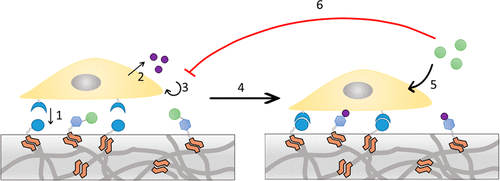当前位置:
X-MOL 学术
›
Biomacromolecules
›
论文详情
Our official English website, www.x-mol.net, welcomes your
feedback! (Note: you will need to create a separate account there.)
Introduction of Enzyme-Responsivity in Biomaterials to Achieve Dynamic Reciprocity in Cell-Material Interactions.
Biomacromolecules ( IF 5.5 ) Pub Date : 2020-08-19 , DOI: 10.1021/acs.biomac.0c00930 Joyce E P Brouns 1 , Patricia Y W Dankers 1
Biomacromolecules ( IF 5.5 ) Pub Date : 2020-08-19 , DOI: 10.1021/acs.biomac.0c00930 Joyce E P Brouns 1 , Patricia Y W Dankers 1
Affiliation

|
Much effort has been made in the development of biomaterials that synthetically mimic the dynamics of the natural extracellular matrix in tissues. Most of these biomaterials specifically interact with cells, but lack the ability to adapt and truly communicate with the cellular environment. Communication between biomaterials and cells is achieved by the development of various materials with enzyme-responsive moieties in order to respond to cellular cues. In this perspective, we discuss different enzyme-responsive systems, from surfaces to supramolecular assemblies. Additionally, we highlight their further prospects in order to create, inspired by nature, fully autonomous adaptive biomaterials that display dynamic reciprocal behavior. This Perspective shows new strategies for the development of biomaterials that may find broad utility in regenerative medicine applications, from scaffolds for tissue engineering to systems for controlled drug delivery.
中文翻译:

在生物材料中引入酶响应性,以实现细胞-材料相互作用中的动态互易性。
人们在开发合成模拟组织中天然细胞外基质动力学的生物材料方面付出了很多努力。大多数这些生物材料与细胞特异性相互作用,但缺乏适应细胞环境并真正与细胞环境沟通的能力。生物材料和细胞之间的通讯是通过开发具有酶响应部分的各种材料来实现的,以响应细胞信号。从这个角度来看,我们讨论了从表面到超分子组装体的不同酶响应系统。此外,我们还强调了它们的进一步前景,以便在大自然的启发下创造出具有动态互惠行为的完全自主的自适应生物材料。这一观点展示了生物材料开发的新策略,这些策略可能在再生医学应用中找到广泛的用途,从组织工程支架到受控药物输送系统。
更新日期:2020-08-19
中文翻译:

在生物材料中引入酶响应性,以实现细胞-材料相互作用中的动态互易性。
人们在开发合成模拟组织中天然细胞外基质动力学的生物材料方面付出了很多努力。大多数这些生物材料与细胞特异性相互作用,但缺乏适应细胞环境并真正与细胞环境沟通的能力。生物材料和细胞之间的通讯是通过开发具有酶响应部分的各种材料来实现的,以响应细胞信号。从这个角度来看,我们讨论了从表面到超分子组装体的不同酶响应系统。此外,我们还强调了它们的进一步前景,以便在大自然的启发下创造出具有动态互惠行为的完全自主的自适应生物材料。这一观点展示了生物材料开发的新策略,这些策略可能在再生医学应用中找到广泛的用途,从组织工程支架到受控药物输送系统。











































 京公网安备 11010802027423号
京公网安备 11010802027423号